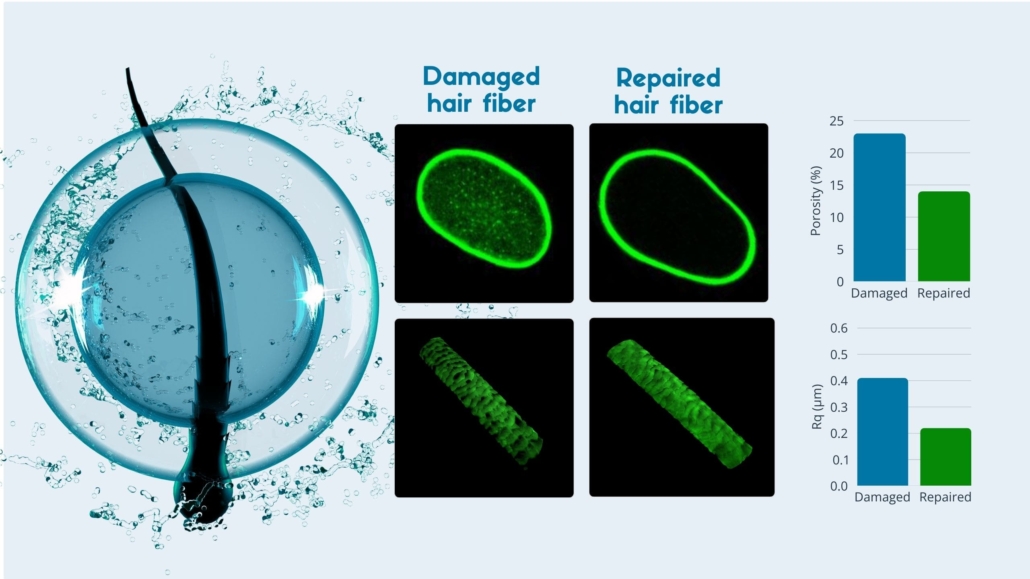Dual Cuticle Integrity Protocols: setting a new standard in hair fiber evaluation
The haircare market is undergoing constant evolution, driven by a growing demand for scientifically substantiated performance. In this context, the ability to rigorously demonstrate a product’s efficacy on the hair fiber has become a strategic differentiator. The Dual Cuticle Integrity Protocol, result of a collaboration between the teams of Transderma Systems and Kamax Innovative System, addresses this need through a dual evaluation of two relevant hair parameters: cuticle porosity and surface roughness.
This innovative method of hair analysis provides reliable, visual, and quantitative data to support performance claims for both cosmetic formulations and hair styling devices.
A combined analysis of cuticle porosity and roughness to assess haircare performance
Performance assessment of haircare products often relies on indirect parameters such as breakage, elasticity, or subjective assessments of touch and shine. Yet many of the most common claims—repair, protection, softness, smoothing—are closely tied to the structural integrity of the hair cuticle.
To meet the demand for scientific objectification, Transderma Systems and Kamax Innovative System have developed a unified analytical protocol: the Dual Cuticle Integrity Protocol. This approach enables the simultaneous assessment of two complementary aspects of hair health: porosity and surface roughness.
A single method, two fundamental insights
This protocol is based on the combined measurement of two key physical parameters:
• Cuticle porosity, which reflects the cohesion of the cuticle scales and the ability of the cuticle to act as a protective barrier.
• Surface roughness, an indicator of cuticle opening, closely associated with perceived smoothness and shine.
Both parameters are measured on the same hair strands under standardized experimental conditions, with or without treatment.
This comprehensive approach provides a complete view of the impact of a given formula on the external structure of the hair fiber.
Cuticle porosity assessment – Transderma Systems’ method
This method objectively evaluates the protective or repairing power of a haircare treatment by quantifying the porosity of the cuticle—its ability to prevent external elements from penetrating the hair fiber.
Methodology
Hair strands, treated or untreated, are placed in contact with a calibrated solution containing a fluorescent tracer with a known diffusion rate through intact cuticles. The fibers are then transversely sliced, and the location of the tracer is determined via confocal microscopy.
Observation
The fluorescence intensity observed in the cross-section reflects the degree of cuticle porosity. A strong signal indicates a permeable and potentially damaged cuticle. A weak signal denotes cohesive scales forming an effective barrier.
Data output
• Cross-sectional images showing tracer penetration
• Average fiber coloring rate, expressed as a percentage
• Analysis performed on at least 25 fibers per condition
Interpretation
A significant decrease in fiber coloring between the untreated and treated samples indicates improved scale cohesion, and thus, a protective or repairing effect from the tested formulation.
Cuticle roughness analysis – Kamax Innovative System’s XFluo® 3D method
Kamax’s XFluo® 3D technology enables high-precision visualization of the hair fiber surface.
Methodology
Hair strands, treated or untreated, are exposed to a fluorescent surface marker. Fibers are then analyzed using XFluo® 3D (confocal microscopy). Following 3D reconstruction of the fiber, roughness is quantified directly at the surface.
Observation
This method reveals the alignment of cuticle scales, the presence of irregularities or raised areas, and visual effects induced by the treatment such as smoothing or protective film formation.
Data output
• Ultra high-definition surface images,
• Exploitable quantitative data: Rq value (root mean square roughness), expressed in micrometers,
• Realistic hair visuals with customizable hair color rendering,
• Pre/post-treatment comparisons allow for precise interpretation.
Interpretation
A significant drop in Rq indicates a reduction in surface roughness, revealing a smoothing, coating, or conditioning effect.

Examples of quantitative result
The results offer a precise and meaningful interpretation of the treatment’s impact.
| Parameter | Control | Treated | Change |
| Mean porosity (%) | 78,5 % | 43,2 % | − 45,0 % |
| Roughness Rq (µm) | 0,53 µm | 0,26 µm | − 50,9 % |
These results demonstrate a significant reduction in fiber porosity and improved surface uniformity—evidence of combined protective and smoothing effects.
Scientific and marketing valorization
Beyond its rigorous methodology, this protocol offers strategic value for brands, formulators, and ingredient suppliers:
• Results are both quantifiable (porosity, roughness) and visual (confocal and high-resolution imaging).
• Visual outputs can be leveraged in presentations, marketing materials, or technical dossiers.
• The protocol supports scientifically grounded and differentiating claims:
– Protects the hair fiber from external aggressions
– Repairs damaged cuticles
– Reduces porosity
– Smoothes the cuticle surface
– Minimizes the impact of thermal and chemical treatments
– Forms a protective film
– Enhances softness, manageability, and shine
– Conditions the hair surface
Universal applicability
The Dual Cuticle Integrity Protocol was designed to accommodate the diversity of hair types. It is suitable for straight, wavy, curly, or coily hair, of Caucasian, Asian, or South American origin.
Tests can be conducted on virgin hair or hair subjected to controlled stress: thermal (e.g., blow-drying, straighteners), chemical (e.g., bleaching), or environmental (e.g., UV).
This flexibility ensures that results reflect real-world usage conditions.
The Dual Cuticle Integrity Protocol represents a methodological advance in the evaluation of haircare efficacy. By combining cuticle porosity analysis with 4K optical surface imaging via XFluo® 3D, it provides a holistic view of how a product affects the structural integrity of the hair fiber.
Robust, visual, reproducible, and aligned with the needs of R&D and marketing teams alike, this protocol is a key tool for both scientific validation and commercial differentiation of next-generation haircare solutions.
For more information or to request the technical brochure:
Contact: Alain Boucaud – Transderma Systems
Email: alain.boucaud@transderma.fr


